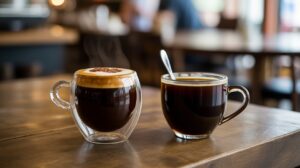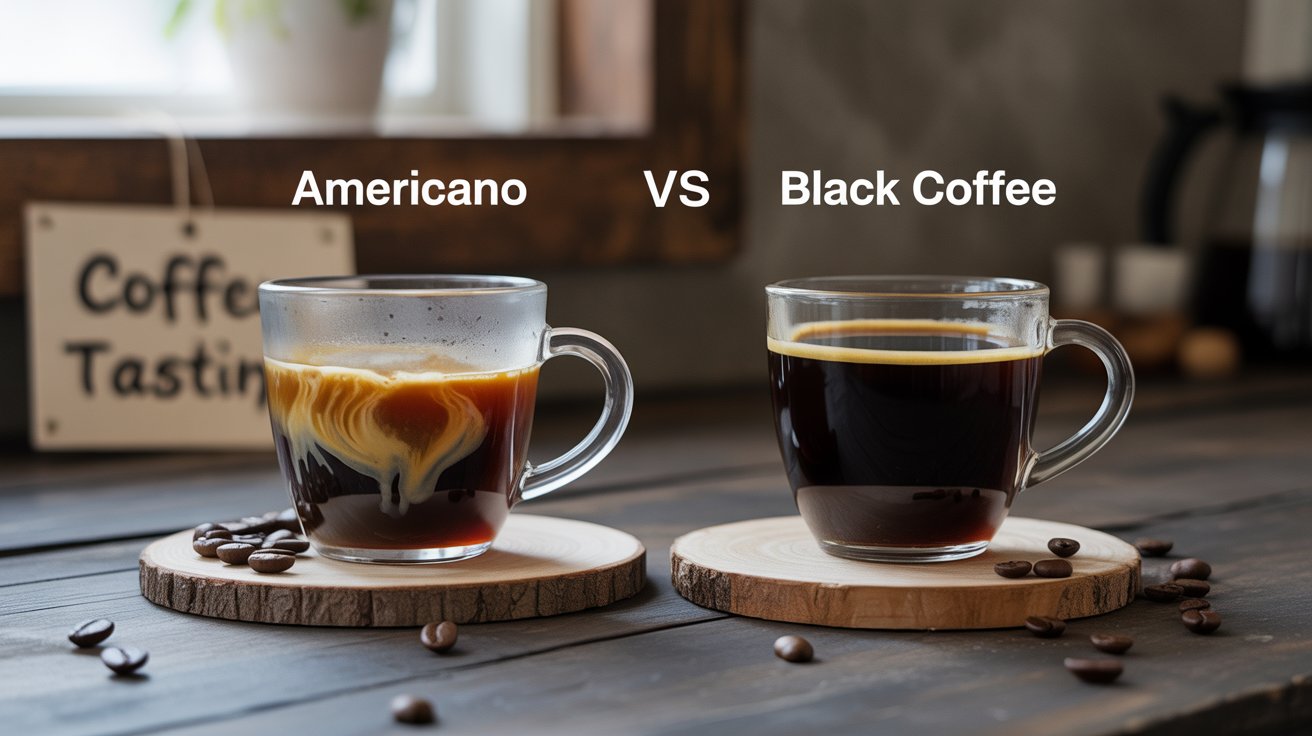If you’ve ever stood at a café counter wondering, “Is an Americano just black coffee with a fancy name?” you’re not alone. The truth: they may look alike, but they deliver very different flavors, caffeine levels, and brewing methods.
Here’s the deal. An Americano vs Black Coffee showdown isn’t just about semantics—it’s about how you want your cup to taste, how much gear you need at home, and even how your body feels after drinking it.
I remember my first mix-up. I ordered an Americano expecting the bold, nuanced punch of my usual pour-over. Instead, I got a smoother, espresso-forward drink that felt like a completely different experience. That’s the exact confusion most coffee lovers run into—and why we’re breaking it down clearly, without fluff.
By the end of this guide, you’ll know not only the difference, but also which one fits your taste buds, budget, and brewing setup.
What Are They—and How Do They Differ?
If you’ve ever looked at an Americano and a cup of black coffee side by side, they seem identical: dark, hot, no milk in sight. But under the surface, they’re completely different drinks. One comes from an espresso shot diluted with hot water. The other comes from ground beans brewed directly through methods like pour-over or French press.
Let’s break it down.
What Is an Americano?
An Americano is simple in concept: pull a shot (or two) of espresso, then add hot water. Most baristas use a 1:3 or 1:4 ratio of espresso to water, though ratios vary by café.
The origin story matters too. During World War II, American soldiers in Italy found local espresso far too strong. To make it taste closer to the drip coffee they knew, they diluted it with hot water—hence the “Americano” was born. (Sources: Wikipedia, Corner Coffee Store, Qavashop).
Real-world note: If you love the smooth body of espresso but don’t want the intensity, Americano is your go-to. You get crema and complexity, stretched into a longer, more sippable drink.
What Is Black Coffee?
Black coffee is brewed coffee without milk, cream, or sugar. It’s the foundation of countless traditions, from a pour-over in Tokyo to a drip machine in New York or a French press in Paris.
Unlike an Americano, it doesn’t rely on espresso. Instead, hot water extracts flavor directly from the grounds over a few minutes. Brewing styles vary widely—Chemex, AeroPress, siphon, even cowboy coffee—but the unifying trait is purity.
(Sources: Corner Coffee Store, Qavashop).
Tip from experience: Black coffee showcases the bean’s origin best. A washed Ethiopian will taste bright and citrusy; a Brazilian roast leans chocolatey. None of that nuance gets muted by dilution.
Quick Comparison Table
| Feature | Americano | Black Coffee |
|---|---|---|
| Base | Espresso shot + hot water | Brewed grounds + hot water |
| Equipment | Espresso machine, grinder | Drip brewer, pour-over, French press |
| Volume | 6–12 oz | 8–16 oz |
| Flavor | Smooth, balanced, crema-topped | Bold, varied, origin-driven |
| Caffeine | ~75–150 mg (depends on # of shots) | ~95–200 mg (depends on method) |
| History | WWII Italy, American soldiers | Global, centuries-old brewing |
Taste, Texture & Crema: Understanding the Sensory Experience

Here’s where the two drinks diverge dramatically.
Americano: smoother body, a touch of bitterness, and a lighter mouthfeel. The crema—that golden foam on top—adds a velvety texture, though it thins out as water stretches the espresso.
Black coffee: stronger flavor swings. Depending on the bean, it might be delicate and tea-like, or bold and smoky. Brewing directly from grounds means you taste the bean’s terroir more clearly.
Crema deserves special attention. In an Americano, hot water often breaks down the crema. In a long black (a close cousin), the order is reversed: water first, then espresso. This preserves the crema, leading to richer aromatics and a different sensory profile (Corner Coffee Store, HiBREW, Coffee Stack Exchange).
The difference is subtle but real. In fact, a 2025 Guardian report noted that UK cafés are shifting—long blacks now make up nearly 1 in 10 coffee orders, thanks to their brighter, crema-rich taste (The Guardian).
First-hand insight: When I compared the three side by side—black coffee, Americano, and long black—the Americano felt mellow, the black coffee more origin-driven, and the long black like a sweet spot in between.
Caffeine Face-Off
So, which one actually packs more caffeine—an Americano or black coffee? The answer: it depends on volume, not just concentration.
A single espresso shot has ~63–75 mg of caffeine. When you turn that into an Americano by adding water, the caffeine doesn’t increase—it just spreads out in more liquid. A typical 12 oz Americano with two shots comes in around 120–150 mg of caffeine (Tank Coffee, Corner Coffee Store).
A standard 8 oz cup of black coffee brewed by drip or pour-over averages 95–200 mg, depending on bean type, grind size, and brew time (HWC Coffee).
Bottom line: black coffee often wins on caffeine per cup, but an Americano lets you control intensity by choosing one, two, or even three shots.
Espresso vs. Brewed Extraction Explained
Espresso is concentrated because it’s extracted quickly—about 25–30 seconds—under 9 bars of pressure. That creates less volume but high intensity.
Black coffee uses immersion or percolation methods. Hot water extracts caffeine and oils over several minutes, producing more liquid and a wider flavor spectrum.
Think of it this way:
Espresso = short, dense, high-pressure burst.
Black coffee = long, steady soak.
Both can deliver similar total caffeine, but the experience—and how your body absorbs it—feels very different.
Mini Caffeine Calculator
This quick tool would help someone see: “Two shots in a 10 oz Americano = ~140 mg. My 12 oz drip coffee = ~144 mg.” Suddenly, the choice isn’t about caffeine—it’s about flavor and ritual.
Brewing & Equipment
If you’re deciding between Americano and black coffee at home, your gear and process will shape the experience just as much as the beans.
Making an Americano
Here’s the straightforward method:
Pull one or two espresso shots.
Heat water separately to about 160–170°F (not boiling).
Pour hot water into your cup first (optional for crema preservation), then add the espresso.
The standard ratio is 1 part espresso to 3–4 parts water, but you can adjust strength to taste (Corner Coffee Store, Wikipedia).
Pro tip: Reverse the order and pour espresso over water—you’ve just made a “long black,” which keeps more crema.
Making Black Coffee
Brewing black coffee offers far more flexibility:
Pour-over (Chemex, V60): clean, tea-like clarity.
Drip machine: convenience and consistency.
French press: bold, heavy body with natural oils.
AeroPress: hybrid between espresso and drip, fast and portable.
Each method highlights different flavor compounds. For example, Ethiopian beans brewed as pour-over showcase bright citrus notes, while a Colombian French press emphasizes chocolate and nuttiness.
Americano vs. Long Black (Bonus)
Here’s where coffee nerds really split hairs.
Americano: espresso first, then hot water → thinner crema, smoother body.
Long black: hot water first, espresso on top → thicker crema, richer aroma (HiBREW, Coffee Stack Exchange).
This small detail changes mouthfeel and perception. And consumers are catching on.
In fact, a 2025 Guardian report revealed that UK cafés now serve long blacks as nearly 9% of coffee orders, eating into Americano’s dominance. The reason? More crema equals more perceived flavor depth.
First-hand lesson: When I introduced long blacks at my own café menu test, customers described it as “a smoother Americano with extra character.” Many switched and never looked back.
👉 Takeaway: If you want gear-light brewing with bean-forward clarity, go black coffee. If you want espresso flavor without the intensity, go Americano. And if you’re chasing café-culture trends, try a long black—you’ll see why it’s gaining ground globally.
Pros & Cons at a Glance
When it comes down to choosing between an Americano and black coffee, both shine in different ways. The key is knowing which strengths—and trade-offs—matter most to you.
Americano
Pros
Smooth, rounded body with less bitterness.
Customizable strength by adjusting shot count or water ratio.
Carries the depth and crema-like texture of espresso.
Cons
Requires an espresso machine or capsule system—higher barrier to entry.
Less diversity in flavor nuance compared to brewed methods (Corner Coffee Store).
Black Coffee
Pros
Simple gear: French press, pour-over, drip maker—easy entry point.
Multiple brewing methods unlock wide flavor profiles, from fruity Ethiopian to chocolatey Colombian.
Highlights bean origin more transparently.
Cons
Strength is harder to fine-tune without experience.
Over-extraction risks bitterness or sourness.
Who Should Choose Which? (Use Cases)
Still not sure which fits your lifestyle? Think about context.
Americano is ideal for:
Espresso lovers who want a smoother, less intense daily drink.
Travelers needing a consistent café experience anywhere in the world.
Professionals chasing a fast energy boost without the “coffee jitters.”
Black Coffee is ideal for:
Minimalists who prefer simple brewing and minimal gear.
Flavor purists who want to taste terroir, roast level, and bean origin.
Budget-conscious drinkers—since a $20 French press can outlast years of daily use.
Don’t Forget the Iced Versions
Iced Americano: chilled espresso shots topped with cold water, crisp and strong without dilution from melting ice.
Chilled Black Coffee: either cooled drip, pour-over, or cold brew. Cold brew especially offers a naturally sweet, low-acid profile that wins over iced coffee skeptics.
Local & Cultural Trends
Preferences aren’t just personal—they’re cultural.
In the UK, the long black has surged to nearly 9% of all café coffee orders, according to The Guardian. The appeal lies in preserving the crema, giving the cup a silkier texture and fuller flavor than a standard Americano.
Meanwhile, in U.S. specialty cafés, black coffee still dominates tastings, cuppings, and third-wave menus because it showcases single-origin beans at their purest.
👉 Translation: If you hang out in indie coffee shops, black coffee signals “bean geek.” If you order in mainstream cafés or airports, Americano signals “espresso fan who likes it smooth.”
Final Thoughts
At first glance, an Americano and black coffee look the same. But their differences run deeper—in flavor, caffeine, and even culture. An Americano delivers espresso smoothness with water’s balance. Black coffee showcases bean origin and brew method in its purest form.
FAQs
What’s more caffeinated—Americano or black coffee?
It depends. A typical 8 oz black coffee has about 95–200 mg of caffeine, while a double-shot Americano averages 130–150 mg. The real difference comes down to cup size, bean variety, and brew strength.
Is long black just a fancier name for Americano?
No. Both combine espresso and hot water, but the order flips. In an Americano, water is poured over espresso. In a long black, espresso is poured over water—preserving the crema and delivering a bolder, more aromatic cup.
Can I recreate Americano taste with instant coffee?
Not exactly. Instant coffee is brewed coffee that’s been dehydrated, so when you add water, it resembles diluted black coffee. It won’t capture espresso’s crema, mouthfeel, or concentrated flavor.
Which is healthier—Americano or black coffee?
Both are naturally low-calorie and rich in antioxidants when consumed plain. Health differences depend more on the beans (origin, roast) and preparation style than on whether you choose an Americano or black coffee.

Shahriar brings a unique blend of storytelling prowess and digital expertise to Daily Coffee Guide. With a background in SEO and content strategy, he ensures our articles on Beans, Coffee, Tea, and Drinks are both engaging and discoverable. His passion for coffee culture drives him to explore and share the rich narratives behind every cup.

